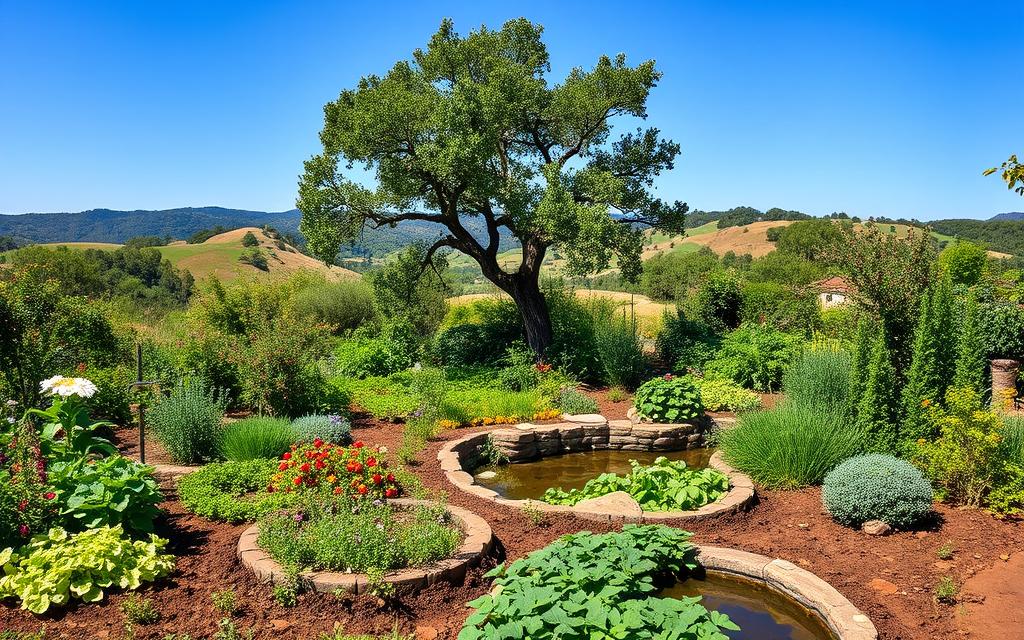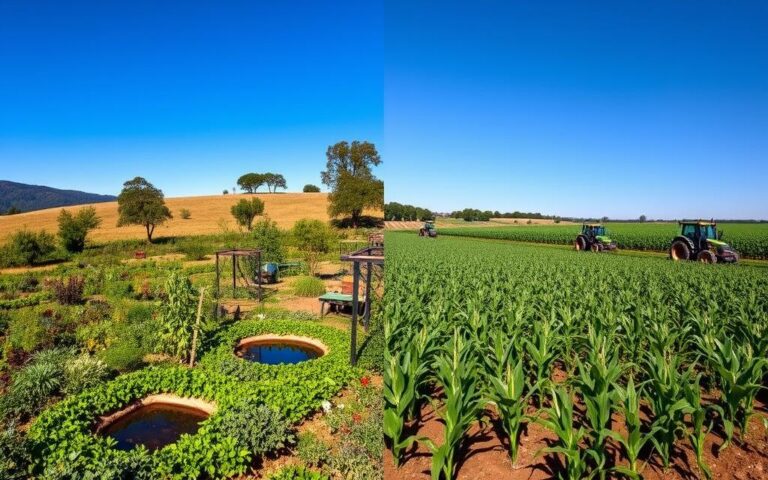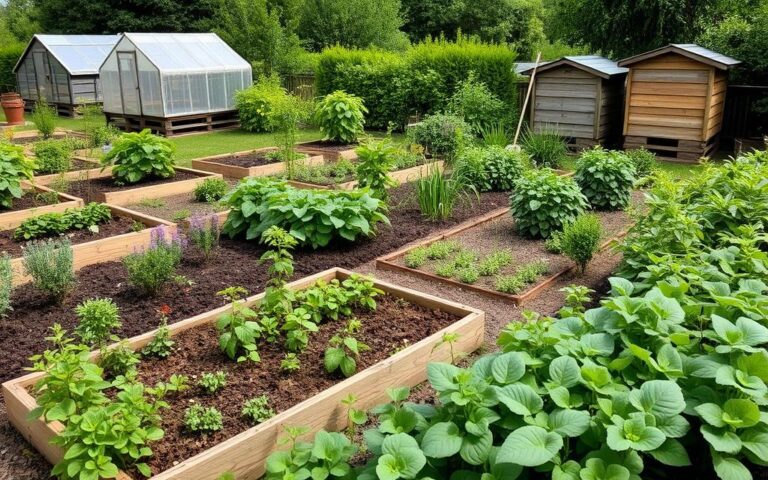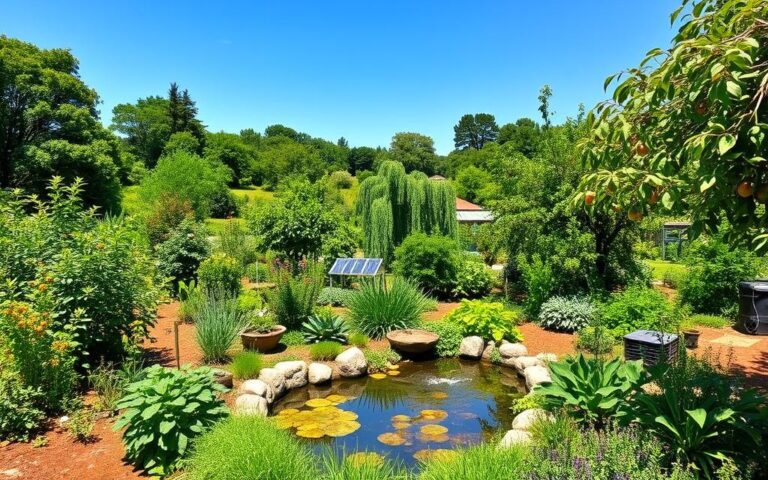Did you know that 70% of the world’s biodiversity is lost because of bad farming? This shows we need better ways to farm and live. Permaculture offers a solution by teaching us to live in harmony with nature. It’s all about creating productive ecosystems.

Learning about permaculture helps us make a better future. It focuses on growing food in a way that’s good for the planet. The 12 principles of permaculture are key to making this happen. They help us create ecosystems that thrive and support us.
Understanding the Core Principles of Permaculture
Permaculture is a way to design sustainable ecosystems. It focuses on working with nature to create systems that benefit both humans and the environment. This method is based on organic gardening and caring for the environment.
The heart of permaculture is to use energy wisely. This means catching and storing water, sunlight, and nutrients. By doing this, permaculture helps ecosystems thrive while being kind to the planet. Key strategies include:
- Creating diverse ecosystems that can handle challenges
- Using renewable energy like solar and wind
- Building efficient irrigation systems to save water
These strategies help us build sustainable ecosystems. They offer many benefits, like fresh food, clean water, and biodiversity. As we face environmental issues, permaculture’s principles are crucial for a better future.

Many people have shaped permaculture over time. It keeps growing and improving. Looking ahead, permaculture’s role in caring for our planet will only grow stronger.
Observation and Natural Integration
Embracing holistic farming means learning from nature. We study the complex links in resilient ecosystems to improve farming. This way, we aim for balanced and thriving lands.
Observation in permaculture helps us see nature’s patterns. For instance, trees shade us, take in CO2, and release oxygen. These actions guide our planting and land use. By copying nature, we build diverse and resilient ecosystems.
- Creating polycultures that mimic natural ecosystems
- Using crop rotation and cover cropping to enhance soil health
- Implementing conservation tillage to reduce soil erosion
These methods help us build resilient ecosystems. They also boost our farm’s health and output. As we keep learning from nature, we make farming more sustainable and regenerative.
| Strategy | Benefits |
|---|---|
| Polycultures | Increased biodiversity, improved pest management |
| Crop rotation and cover cropping | Enhanced soil health, reduced erosion |
| Conservation tillage | Reduced soil disturbance, improved water retention |
Energy Systems and Resource Management
Effective energy systems and resource management are key for sustainable agriculture and regenerative design. By getting a yield and using renewable resources, we can lessen our environmental impact. Innovative ways to capture and store energy, like solar and wind power, help us use resources better.
In sustainable agriculture, energy systems are vital for cutting down on non-renewable resources. By using regenerative design, farmers can make ecosystems that are self-sustaining. This not only helps the environment but also improves health and well-being for everyone.
Some important strategies for energy systems and resource management include:
- Capturing natural energy sources, such as solar and wind power
- Implementing storage solutions, such as batteries and hydroelectric power
- Maximizing resource efficiency through reduced waste and optimized usage
By using these strategies, we can help make a more sustainable future. Experts say, “sustainable agriculture and regenerative design are key for a healthy environment.”
| Energy Source | Benefits | Challenges |
|---|---|---|
| Solar Power | Renewable, zero emissions, low maintenance | Intermittent energy source, high upfront costs |
| Wind Power | Renewable, low operating costs, scalable | Intermittent energy source, noise pollution, visual impact |
Productive Ecosystems and Yield Management
Creating and managing productive ecosystems is key for organic gardening and environmental stewardship. By using self-regulation and feedback, and renewable resources, we can improve our gardening. This helps our environment too.
Some ways to design and keep ecosystems productive include:
- Using compost and natural fertilizers to promote soil health
- Implementing crop rotation and diversification to support biodiversity
- Conserving water through efficient irrigation systems
These strategies help us create ecosystems that support many plants and animals. They also help us live more sustainably. Experts say, “A well-designed ecosystem can produce a lot while being gentle on the environment.”
“The key to successful ecosystem management is to understand the intricate relationships between living organisms and their environment, and to use this knowledge to create balanced and productive ecosystems.”
A study on organic gardening showed that using renewable resources and reducing waste helps the environment. It also stressed the importance of environmental stewardship for healthy ecosystems.
| Strategy | Benefits |
|---|---|
| Composting | Reduces waste, promotes soil health |
| Crop rotation | Supports biodiversity, improves soil fertility |
| Water conservation | Reduces water waste, promotes efficient irrigation |
Self-Regulation and Renewable Resources
In permaculture, self-regulation is key for thriving farming systems. Farmers design from patterns to details, creating balanced environments. This method uses renewable resources well, cutting down on waste and external inputs.
Feedback loops are vital for self-regulation. They help farmers keep their ecosystems healthy. By observing soil, water, and biodiversity, farmers can adjust their practices. This keeps their systems productive and resilient.
Implementing Feedback Loops
Feedback loops can be set up in many ways. For example:
- Monitoring soil moisture for better irrigation
- Tracking crop yields to improve farming
- Regular biodiversity checks for conservation
By focusing on self-regulation and renewable resources, farmers build strong ecosystems. These systems not only yield well but also help the environment. This is crucial for facing climate change and other challenges.
Sustainable Resource Utilization
Using resources sustainably is essential for healthy ecosystems. Renewable energy like solar and wind power reduces fossil fuel use. Efficient irrigation and drought-resistant crops also save water, a precious resource.
Pattern Recognition in Permaculture Design
Pattern recognition is key in permaculture design. It helps create systems that are both resilient and diverse. By seeing patterns in nature, designers can make designs that work well with the environment. This way, we get more effective and sustainable permaculture practices.
Some important principles of pattern recognition in permaculture include:
- Using small and slow solutions to minimize environmental impact
- Valuing diversity and promoting biodiversity in ecosystem design
- Encouraging resilience through the use of regenerative design principles
By using these principles, permaculture designers can make systems that are not just sustainable but also regenerative. This method can change how we interact with the environment. It helps us have a more harmonious and balanced relationship with nature.
As we keep learning and improving permaculture design, pattern recognition will become even more important. By adopting this approach, we can build a more sustainable future. A future filled with regenerative design and a deep love for the natural world.
Integration and Diversity in Ecosystem Development
Permaculture teaches us that integration and diversity are key to a healthy ecosystem. By using sustainable agriculture and organic gardening, we can build complex systems. These systems support many plants and animals, boosting biodiversity and ecological balance.
One important strategy is to value the marginal and adapt to change. By focusing on edges and marginal areas, we create diverse microclimates. This method works for both small gardens and large farms.
Creating Symbiotic Relationships
Symbiotic relationships are vital in integrated ecosystems. Pairing plants and animals that complement each other creates beneficial relationships. For instance, growing nitrogen-fixing legumes with nitrogen-requiring crops reduces the need for synthetic fertilizers and improves soil health.
Biodiversity Enhancement Strategies
There are several ways to boost biodiversity in ecosystems. Some strategies include:
- Planting a diverse range of native species
- Creating habitat for beneficial insects and animals
- Using organic gardening practices to reduce chemical use
- Implementing crop rotation and polyculture systems
Edge Effect Utilization
The edge effect is the unique environment at the boundary of two ecosystems. By using the edge effect, we can create diverse and productive systems. This is done by planting species that thrive in these conditions, like shrubs and trees that tolerate different light and soil conditions.
| Strategy | Description |
|---|---|
| Polyculture | Planting multiple crops together to promote diversity and reduce pests and diseases |
| Agroforestry | Integrating trees into agricultural systems to promote ecological balance and biodiversity |
| Permaculture design | Designing ecosystems that mimic natural patterns and processes to promote sustainability and resilience |
Implementing Small-Scale Solutions
Small-scale solutions in permaculture can make a big difference in holistic farming and resilient ecosystems. These solutions help create sustainable environments. They promote biodiversity and cut down on waste. Examples include backyard gardens, community gardens, and small farms.
These projects can fit into many settings and help the environment. For example, a small farm can use permaculture to build a strong ecosystem against climate change. A community garden can also use holistic farming to make a space that benefits everyone.
When starting small-scale permaculture projects, consider a few things:
- Check the local climate and soil to pick the right crops and irrigation systems
- Use natural resources like solar power and rainwater to cut down on energy use
- Plant a variety of crops and use companion planting to create diverse ecosystems
- Set up efficient waste management, like composting and recycling, to reduce waste
By following these tips and using permaculture, you can make a difference in holistic farming and resilient ecosystems. As more people look for sustainable ways to farm, small-scale permaculture will become even more important.
Starting small-scale permaculture projects is key to a sustainable food system. By applying permaculture principles and thinking about the local area, you can build resilient ecosystems. These ecosystems support biodiversity and reduce waste, leading to a more holistic farming approach.
| Project Type | Benefits | Challenges |
|---|---|---|
| Backyard Garden | More food, less waste | Small space, lots of work |
| Community Garden | Brings people together, teaches | Needs coordination, money |
| Small-Scale Farm | More crops, better soil | Scaling up, finding markets |
Conclusion: Applying Permaculture Principles in Daily Life
The principles of permaculture are powerful for changing how we live. They help us live in harmony with nature. By using these principles, we can make our surroundings better for everyone.
Starting small is key to a greener future. You can grow your own food, use clean energy, or care for the planet. Every action helps make the world a better place.
Remember, the journey is about progress, not being perfect. Start where you are and learn as you go. Every step forward helps us live better with nature. Together, we can make a big difference.
FAQ
What are the 12 Principles of Permaculture?
The 12 Principles of Permaculture are: 1. Observe and Interact 2. Catch and Store Energy 3. Obtain a Yield 4. Apply Self-Regulation and Accept Feedback 5. Use and Value Renewable Resources 6. Produce No Waste 7. Design from Patterns to Details 8. Integrate Rather Than Segregate 9. Use Small and Slow Solutions 10. Use and Value Diversity 11. Use Edges and Value the Marginal 12. Creatively Use and Respond to Change
What are the origins of Permaculture Design?
Permaculture design started in the 1970s by Bill Mollison and David Holmgren. They wanted a better way to farm and manage land. Their ideas came from indigenous farming, ecology, and thinking about systems.
Why are the Principles of Permaculture relevant today?
Today, we face big challenges like climate change and environmental damage. The Principles of Permaculture offer a way to design systems that are sustainable and work with nature.
How can observing and interacting with nature lead to more sustainable practices?
By watching and working with nature, we can learn how to farm and live better. We can use nature’s ways to make our systems productive and self-regulating.
What are some strategies for capturing and storing natural energy sources?
Permaculture uses solar panels, wind turbines, and more to capture energy. It also stores water and biomass to use less non-renewable resources.
How can self-regulation and feedback loops enhance ecosystem productivity?
Self-regulation and feedback loops help ecosystems stay balanced and adapt. Techniques like companion planting and integrated pest management make systems productive and resilient.
What is the role of pattern recognition in Permaculture design?
Recognizing patterns in nature is key in Permaculture design. By designing from patterns, we create systems that are efficient and in harmony with nature.
How can integrating diverse elements enhance the resilience of a Permaculture system?
Diverse, interconnected elements in Permaculture systems make them resilient. This diversity helps the system withstand and recover from challenges.
What are some examples of small-scale Permaculture solutions?
Small-scale Permaculture includes backyard gardens and community composting. Rainwater harvesting and renewable energy projects also help. These efforts make a big difference in sustainability.




